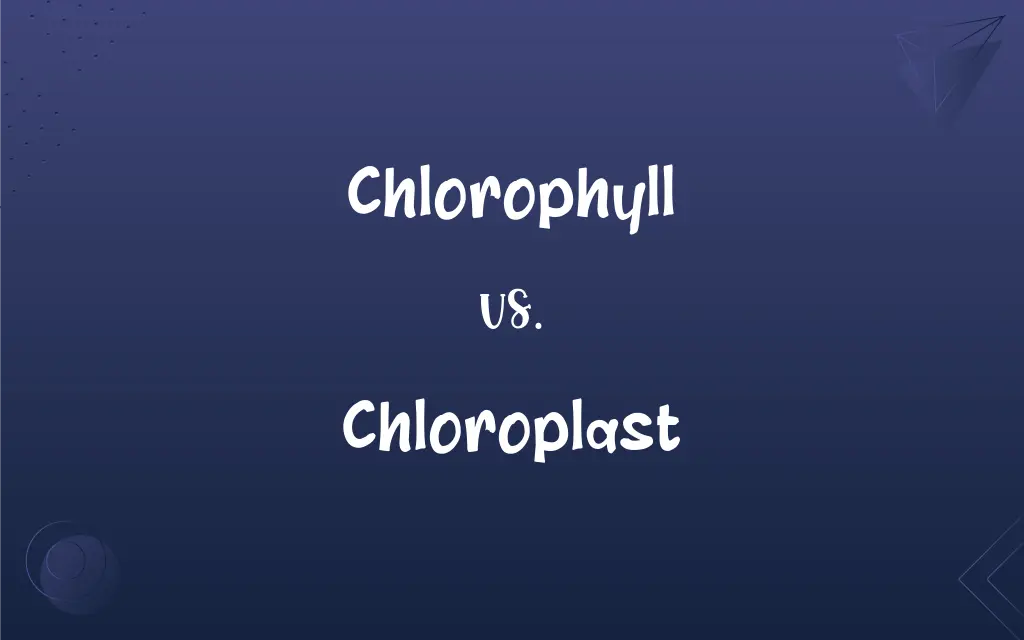Chlorophyll vs. Chloroplast: What's the Difference?
Edited by Aimie Carlson || By Harlon Moss || Updated on October 26, 2023
Chlorophyll is the green pigment in plants facilitating photosynthesis; chloroplasts are the cell organelles where this process occurs.

Key Differences
Chlorophyll is a vital molecule present in green plants and some algae. Its primary role is to absorb sunlight and utilize it to transform carbon dioxide and water into glucose. Chloroplasts, on the other hand, are specialized organelles found within plant cells where the process of photosynthesis, driven by chlorophyll, takes place.
Chlorophyll is often recognized for its vibrant green color, which is responsible for the green hue of plants. This pigment captures light energy from the sun, particularly from the blue and red spectrum, converting it into chemical energy. Chloroplasts house this chlorophyll pigment and provide a structured environment for the various reactions of photosynthesis.
While chlorophyll is essentially a chemical compound, chloroplasts are more complex structures made up of various components. Inside chloroplasts, there are small sac-like structures called thylakoids where chlorophyll resides, facilitating the light-dependent reactions of photosynthesis.
Chlorophyll exists in multiple forms, such as chlorophyll-a and chlorophyll-b, each having unique absorption spectra. These variations enable plants to optimize sunlight absorption. Chloroplasts, in contrast, have a uniform structure across different plant species but vary in number and distribution within plant cells.
To sum it up, chlorophyll is the pigment responsible for capturing sunlight, and chloroplasts are the sites where photosynthesis, facilitated by chlorophyll, takes place.
ADVERTISEMENT
Comparison Chart
Nature
Chemical compound
Cell organelle
Role
Absorbs sunlight for photosynthesis
Site where photosynthesis occurs
Presence
Found in thylakoids within chloroplasts
Found in the cytoplasm of plant cells
Color
Gives plants their green color
Organelle housing green (due to chlorophyll) structures
Variations
Exists in forms like chlorophyll-a, chlorophyll-b
Uniform structure but varies in number in cells
ADVERTISEMENT
Chlorophyll and Chloroplast Definitions
Chlorophyll
Chlorophyll is the green pigment in plants responsible for absorbing sunlight.
The vibrant green of leaves is due to the presence of chlorophyll.
Chloroplast
Chloroplasts are cell organelles in plants where photosynthesis occurs.
The chloroplast is the hub of energy production in plant cells.
Chlorophyll
Chlorophyll plays a pivotal role in the process of photosynthesis.
Without chlorophyll, plants couldn't convert sunlight into energy.
Chloroplast
Chloroplasts house the pigment chlorophyll necessary for light absorption.
Within the chloroplast, chlorophyll captures sunlight and starts the process of photosynthesis.
Chlorophyll
Chlorophyll is found in the thylakoids of chloroplasts.
The thylakoids are packed with chlorophyll, capturing the sun's energy efficiently.
Chloroplast
Chloroplasts have a unique double membrane structure.
The outer and inner membranes of the chloroplast help maintain its internal environment.
Chlorophyll
Chlorophyll has multiple forms like chlorophyll-a and chlorophyll-b.
Different forms of chlorophyll allow plants to utilize various light wavelengths.
Chloroplast
Chloroplasts contain small sac-like structures called thylakoids.
Thylakoids within the chloroplast are the sites where the light reactions of photosynthesis take place.
Chlorophyll
Chlorophyll is essential for plants to produce glucose.
Through photosynthesis, chlorophyll aids in converting carbon dioxide into glucose.
Chloroplast
Chloroplasts play a role in storing and releasing energy in plants.
When plants need energy, the chloroplast releases stored glucose.
Chlorophyll
A waxy blue-black microcrystalline green-plant pigment, C55H72MgN4O5, with a characteristic blue-green alcohol solution. Also called chlorophyll a.
Chloroplast
A plastid that contains chlorophyll and is found in the cells of green plants and algae.
Chloroplast
(cytology) An organelle, found in the cells of green plants and in photosynthetic algae, where photosynthesis takes place, characterized by a high concentration of chlorophyll and two membranes.
Chloroplast
A plastid containing chlorophyll, developed only in cells exposed to the light. Chloroplasts are minute flattened granules, usually occurring in great numbers in the cytoplasm near the cell wall, and consist of a colorless ground substance saturated with chlorophyll pigments. Under light of varying intensity they exhibit phototactic movements. In animals chloroplasts occur only in certain low forms.
Chloroplast
Plastid containing chlorophyll and other pigments; in plants that carry out photosynthesis
FAQs
Can humans benefit from chlorophyll?
Yes, chlorophyll has been cited for various health benefits when consumed.
What color is chlorophyll?
Chlorophyll is green.
Do all plants contain chlorophyll?
Most green plants do, but not all plants rely solely on chlorophyll for photosynthesis.
Is chlorophyll found in fruits?
Yes, in green fruits due to their chlorophyll content.
Do chlorophyll and chloroplasts exist in fungi?
No, fungi do not perform photosynthesis and lack both.
What role does chlorophyll play in plants?
Chlorophyll absorbs sunlight and facilitates photosynthesis.
What's inside a chloroplast?
Chloroplasts contain thylakoids, stroma, and DNA among other components.
What's the significance of the chloroplast's double membrane?
It's likely due to the evolutionary origin of chloroplasts from ancient symbiotic bacteria.
What are chloroplasts?
Chloroplasts are cell organelles in plants where photosynthesis takes place.
Are chloroplasts present in animal cells?
No, chloroplasts are unique to plant cells and some algae.
Are there different types of chlorophyll?
Yes, such as chlorophyll-a and chlorophyll-b.
Can plants survive without chloroplasts?
No, plants need chloroplasts for photosynthesis and energy production.
Do chloroplasts have their own DNA?
Yes, chloroplasts have their own circular DNA, separate from the cell's nuclear DNA.
What happens if chloroplasts malfunction?
The plant may struggle with photosynthesis and energy production.
Why are chloroplasts green?
They appear green because of the chlorophyll they contain.
Is chlorophyll found outside chloroplasts?
Primarily, chlorophyll is housed within the chloroplasts in thylakoids.
How many chloroplasts can be found in a cell?
The number varies, but a plant cell can have several to many hundreds of chloroplasts.
Can you see chlorophyll without a microscope?
Not individually, but its green color is evident in plants.
How do chlorophyll and chloroplasts work together?
Chlorophyll captures sunlight within the chloroplasts to drive photosynthesis.
About Author
Written by
Harlon MossHarlon is a seasoned quality moderator and accomplished content writer for Difference Wiki. An alumnus of the prestigious University of California, he earned his degree in Computer Science. Leveraging his academic background, Harlon brings a meticulous and informed perspective to his work, ensuring content accuracy and excellence.
Edited by
Aimie CarlsonAimie Carlson, holding a master's degree in English literature, is a fervent English language enthusiast. She lends her writing talents to Difference Wiki, a prominent website that specializes in comparisons, offering readers insightful analyses that both captivate and inform.































































